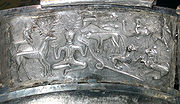
Originally Posted by
Frostwulf
This is not what I have read, they are different. I believe the jastorf culture followed the nordic bronze age. I think they were influenced by the Halstatt cultures but are still different. As far as what they spoke that usually comes from philology and place names in the region such cultures had dwelt.
---------------
J.B. Bury-" Soon after 100BC southern Germany had been occupied, and they were attempting to flood Gaul. This inundation was stemmed by Julius Caesar." pg.5
H.D. Rankin-"Celts and the Classical World"-"By the end of the sixth century BC, the Germans had expanded into Belgium and the southern part of Holland. They occupied both banks of the lower Rhine, and they reached as far south as the Ardennes.
Across Europe the long line of Celtic hill-forts may be said to have restrained German expansion for centuries, though, as we have said, there was considerable intermingling. Certain tribes of Gaul, such as the Aedui, boasted of Germanic descent [east of the Rhine-german not Nordic]. The Belgae also were a mixture [?] of German and Celt. There is no reason to suppose that it was specifically German pressure that detonated the great Celtic invasions of Italy and Bohemia at the end of the fifth century BC. There is no evidence that the line of Celtic fortifications did not hold good at that time. [why is it assumed these were built for protection against Nordic invasion]On the other hand, Celtic pressure seems to have caused Eastern Germanic tribes, such as the Bastarnae, to move eastwards." pg.18-19
The Oxford Classical Dictionary-"The conventional view is that German language and culture originated in northern Germany and land about the western Baltic from about 500BC. Movement of peoples, leading to the reversal of Celtic expansion and Germanic contact with the Mediterranean world, took place from 300BC. In the west, this included the Cimbric migration of the [late] 2nd cent. BC [cimbri were most likely Kelt and not Nordic]-probably also the date of German settlement across the lower Rhine [?]. The early 1st cen. saw the arrival of the Suebi on the upper Rhine. In the east, the Germanic Bastarnae [why are these Nordic] appeared on the borders of Thrace as early as 200BC; and the same period saw the establishment of the distant ancestors of, amongst others, Burgundians, Goths, and Vandals, between the Oder and the Vistula." pg. 635 Contributers: Anderson,Much,L.Schmidt,E.A.Thompson,M.Todd,P.Heather
very interesting information, hopefully I will have the time to read that book.
Originally Posted by cmacq
Originally Posted by cmacq
Originally Posted by cmacq
Originally Posted by blitzkrieg80





 Reply With Quote
Reply With Quote

 7x
7x 3x
3x








 Beside your comments i didn't noticed anything about this thread being nationalistic… I really enjoyed reading blitzkrieg's, Frostwulf's and other comments
Beside your comments i didn't noticed anything about this thread being nationalistic… I really enjoyed reading blitzkrieg's, Frostwulf's and other comments







Bookmarks